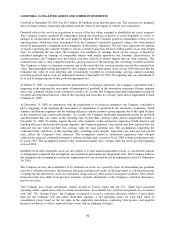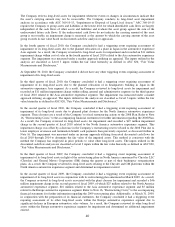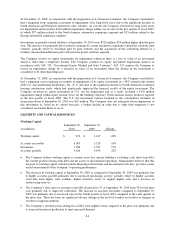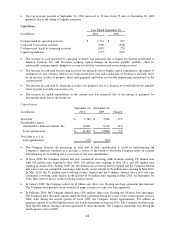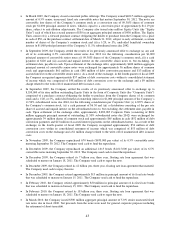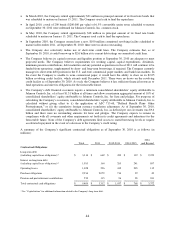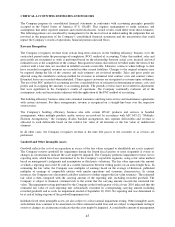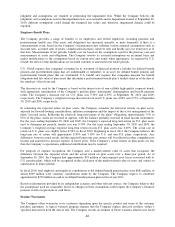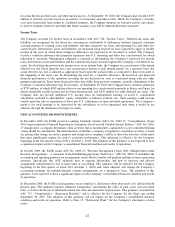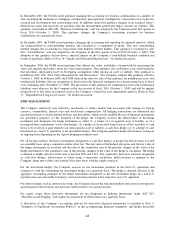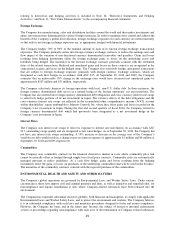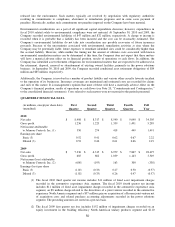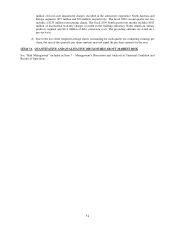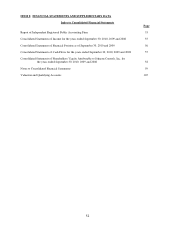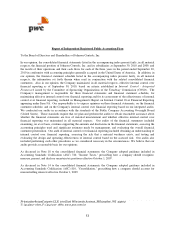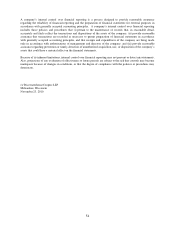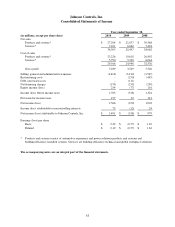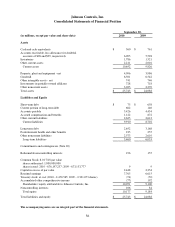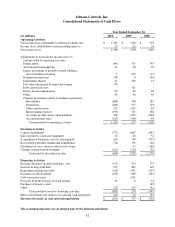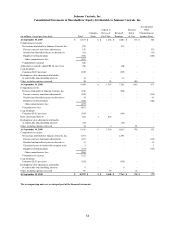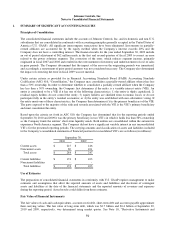Johnson Controls 2010 Annual Report Download - page 49
Download and view the complete annual report
Please find page 49 of the 2010 Johnson Controls annual report below. You can navigate through the pages in the report by either clicking on the pages listed below, or by using the keyword search tool below to find specific information within the annual report.49
relating to derivatives and hedging activities is included in Note 10, ―Derivative Instruments and Hedging
Activities,‖ and Note 11, ―Fair Value Measurements,‖ to the accompanying financial statements.
Foreign Exchange
The Company has manufacturing, sales and distribution facilities around the world and thus makes investments and
enters into transactions denominated in various foreign currencies. In order to maintain strict control and achieve the
benefits of the Company’s global diversification, foreign exchange exposures for each currency are netted internally
so that only its net foreign exchange exposures are, as appropriate, hedged with financial instruments.
The Company hedges 70% to 90% of the nominal amount of each of its known foreign exchange transactional
exposures. The Company primarily enters into foreign currency exchange contracts to reduce the earnings and cash
flow impact of the variation of non-functional currency denominated receivables and payables. Gains and losses
resulting from hedging instruments offset the foreign exchange gains or losses on the underlying assets and
liabilities being hedged. The maturities of the forward exchange contracts generally coincide with the settlement
dates of the related transactions. Realized and unrealized gains and losses on these contracts are recognized in the
same period as gains and losses on the hedged items. The Company also selectively hedges anticipated transactions
that are subject to foreign exchange exposure, primarily with foreign currency exchange contracts, which are
designated as cash flow hedges in accordance with ASC 815. At September 30, 2010 and 2009, the Company
estimates that an unfavorable 10% change in the exchange rates would have decreased net unrealized gains by
approximately $107 million and $51 million, respectively.
The Company selectively finances its foreign operations with local, non-U.S. dollar debt. In those instances, the
foreign currency denominated debt serves as a natural hedge of the foreign operations’ net asset positions. The
Company has also entered into foreign currency denominated debt obligations and cross-currency interest rate swaps
to selectively hedge portions of its net investment in Japan. The currency effects of the debt obligations and the
cross-currency interest rate swaps are reflected in the accumulated other comprehensive income (AOCI) account
within shareholders’ equity attributable to Johnson Controls, Inc. where they offset gains and losses recorded on the
Company’s net investment in Japan. During the first and second quarters of fiscal 2010, the Company retired its
foreign currency denominated debt which had previously been designated as a net investment hedge in the
Company’s net investment in Japan.
Interest Rates
The Company uses interest rate swaps to offset its exposure to interest rate movements. In accordance with ASC
815, outstanding swaps qualify and are designated as fair value hedges. As of September 30, 2010, the Company did
not have any interest rate swaps outstanding. A 10% increase or decrease in the average cost of the Company’s
variable rate debt would result in a change in pre-tax interest expense of approximately $1 million and $4 million at
September 30, 2010 and 2009, respectively.
Commodities
The Company uses commodity contracts in the financial derivatives market in cases where commodity price risk
cannot be naturally offset or hedged through supply base fixed price contracts. Commodity risks are systematically
managed pursuant to policy guidelines. As a cash flow hedge, gains and losses resulting from the hedging
instruments offset the gains or losses on purchases of the underlying commodities that will be used in the business.
The maturities of the commodity contracts coincide with the expected purchase of the commodities.
ENVIRONMENTAL, HEALTH AND SAFETY AND OTHER MATTERS
The Company's global operations are governed by Environmental Laws and Worker Safety Laws. Under various
circumstances, these laws impose civil and criminal penalties and fines, as well as injunctive and remedial relief, for
noncompliance and require remediation at sites where Company-related substances have been released into the
environment.
The Company has expended substantial resources globally, both financial and managerial, to comply with applicable
Environmental Laws and Worker Safety Laws, and to protect the environment and workers. The Company believes
it is in substantial compliance with such laws and maintains procedures designed to foster and ensure compliance.
However, the Company has been, and in the future may become, the subject of formal or informal enforcement
actions or proceedings regarding noncompliance with such laws or the remediation of Company-related substances


